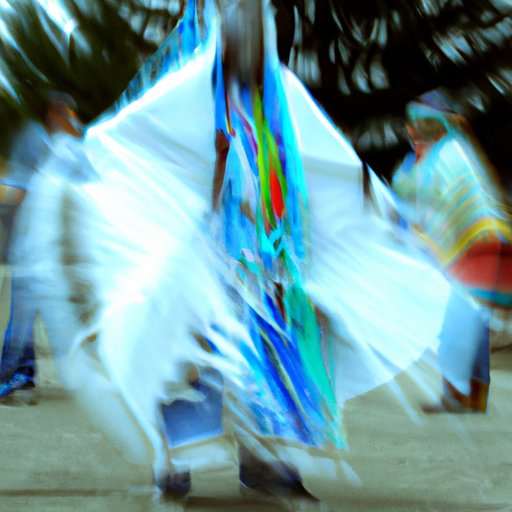Introduction
The ghost dance is an important part of Native American culture and history. It was first introduced in the late 19th century by Wovoka, a Paiute holy man, as a way to bring peace and harmony to all tribes. The purpose of this article is to explore the significance of the ghost dance movement and its impact on both Native Americans and American society.

The Significance of the Ghost Dance to Native American Tribes
The origin of the ghost dance can be traced back to Wovoka, who believed that if all Native Americans followed his teachings, they would be able to restore their lands and live in peace and harmony. He taught that through prayer and dancing, the spirits of their ancestors could help them achieve their goals. As the message spread, many Native American tribes adopted the ghost dance as part of their religious practices.
The ghost dance had a profound effect on Native American culture and tradition. It provided a sense of hope and unity among tribes, reminding them of their shared history and common struggles. It also served as a form of protest against the injustices inflicted upon them by the US government. The ghost dance offered Native Americans a way to express their anger and frustration, while still maintaining their spiritual beliefs.

Exploring the Religious Beliefs Behind the Ghost Dance
At the heart of the ghost dance are spiritual beliefs that are deeply rooted in Native American culture. According to Wovoka’s teachings, the spirits of the dead could help bring peace and prosperity to the living. The ghost dance was seen as a way to communicate with these spirits, as well as to honor their memory.
The ghost dance was also seen as a way to bring about a better future for Native Americans. Through the ritualistic movements, dancers were able to express their hopes and dreams, while also invoking the power of their ancestors to help them achieve their goals. In this way, the ghost dance served as a form of spiritual healing.
Contemporary Interpretations of the Ghost Dance
Over time, the ghost dance has evolved into different forms and interpretations. While some Native American tribes continue to practice the traditional form of the ghost dance, others have adapted it to fit their own cultural beliefs. For example, many contemporary practitioners view the ghost dance as a way to connect with the spirit world and to honor the sacredness of nature.
In addition, the ghost dance has been embraced by other cultures around the world. For instance, in Mexico, the ghost dance is celebrated in the Dia de los Muertos festival. This annual celebration honors the dead and pays tribute to their spirits.
Examining the Influence of the Ghost Dance on Modern Society
Today, the ghost dance continues to have a profound impact on modern society. For example, many contemporary artists have used the ghost dance as a source of inspiration for their work. The movement has also been embraced by the LGBTQ+ community, who use it as a way to celebrate their identity and reclaim their place in society.
In addition, the ghost dance has become a symbol of resistance against oppression. From the Standing Rock protests to the Black Lives Matter movement, the ghost dance has been used as a tool to empower those who have been marginalized and silenced.
Analyzing the Impact of the Ghost Dance on American History
The ghost dance was an important part of American history. It served as a reminder of the strength and resilience of Native Americans, even in the face of extreme adversity. It also helped to shape the development of American culture and identity, as it allowed Native Americans to express their beliefs and values in a meaningful way.
The ghost dance was also a form of protest against the injustices inflicted upon Native American tribes by the US government. By participating in the ritual, Native Americans were able to make their voices heard and to demand justice for their people.

Comparing and Contrasting Different Ghost Dance Movements Around the World
Different countries around the world have their own versions of the ghost dance. For instance, in China, the ghost dance is known as the Jai Ho, which translates to “the Victory Dance”. Similarly, in India, the ghost dance is called the Garba, which means “dancing circle”.
Despite the differences in name and style, all of these dances share the same basic purpose: to honor the spirits of the dead and to invoke their power. They also serve as a reminder of our shared humanity and the importance of preserving our cultural heritage.
Conclusion
The ghost dance is an important part of Native American culture and history. It has served as a powerful tool for spiritual healing and empowerment, and it has had a lasting impact on American society. It is a reminder of our shared humanity and the importance of preserving our cultural heritage. As we look to the future, it is essential that we remember and honor the legacy of the ghost dance.
(Note: Is this article not meeting your expectations? Do you have knowledge or insights to share? Unlock new opportunities and expand your reach by joining our authors team. Click Registration to join us and share your expertise with our readers.)
